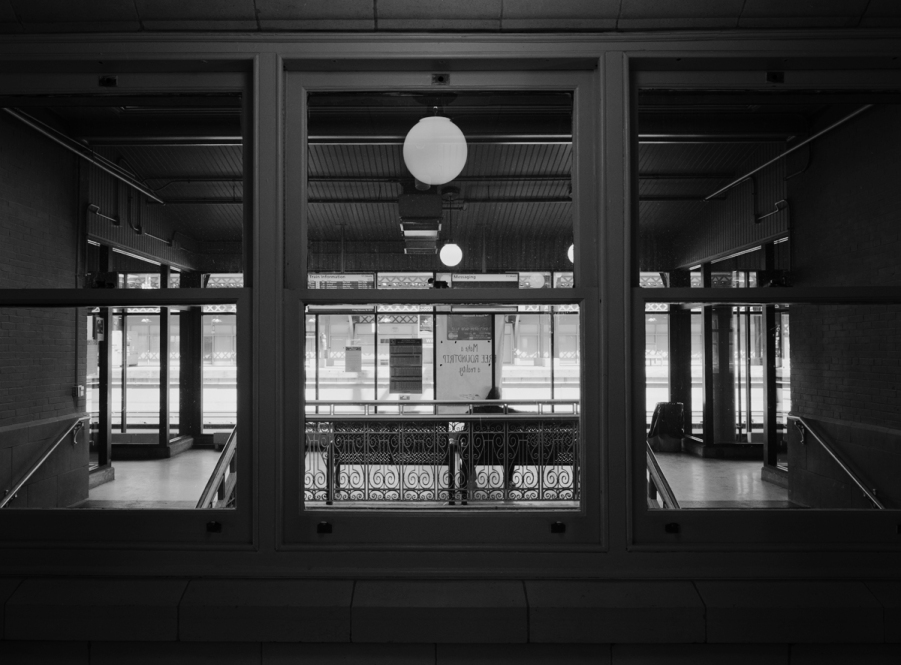Photographs and History: A Change of Venue
Dear friends and followers,
During a recent website rebuild I made the decision to integrate my blog into the new design to have everything under one domain. It has been a great run on WordPress but I have found it very important to have my portfolios along side of what has become a major body of writing, research and imagery both contemporary and historical. I would like to thank all of you for your continued support and encourage you to make the trip with me over to the new location.
Those of you who subscribe to this blog via email, do nothing, I have your info and will add you to my subscription list, if you no longer want to receive these notifications or already are on the list simply unsubscribe, no problem!
Those of you who follow me via the WordPress community please click here if you would like to sign up to receive updates, notifications and the occasional newsletter via email.
Please note that effective this message I will no longer post to this page and on June 10th I will be setting up a permanent re-direct to the new blog, www.michaelfroio.com/blog, don’t forget to update your bookmark for the new site.
Thank you again for your continued support!
Sincerely,
Michael Froio
Preserving the legacy of the Pennsylvania Railroad
At the close of 2014 the Greer Family donated a remarkable piece of Pennsylvania Railroad history in the form of an oversized album of large format photographs made by Frederick Gutekunst (1831-1917) a native of the Germantown section of Philadelphia. Operating out of a studio at 7th and Arch Streets for more than 50 years Gutekunst was considered one of the preeminent photographers in the post-Civil War era. Some of his subjects included noteworthy people like Thomas Eakins and Walt Whitman but also extended beyond portraiture to include architecture and the built environment of the PRR. Before this album surfaced most examples of his work were in the form of stereo views, making this collection of 16×12” large format prints incredibly rare.
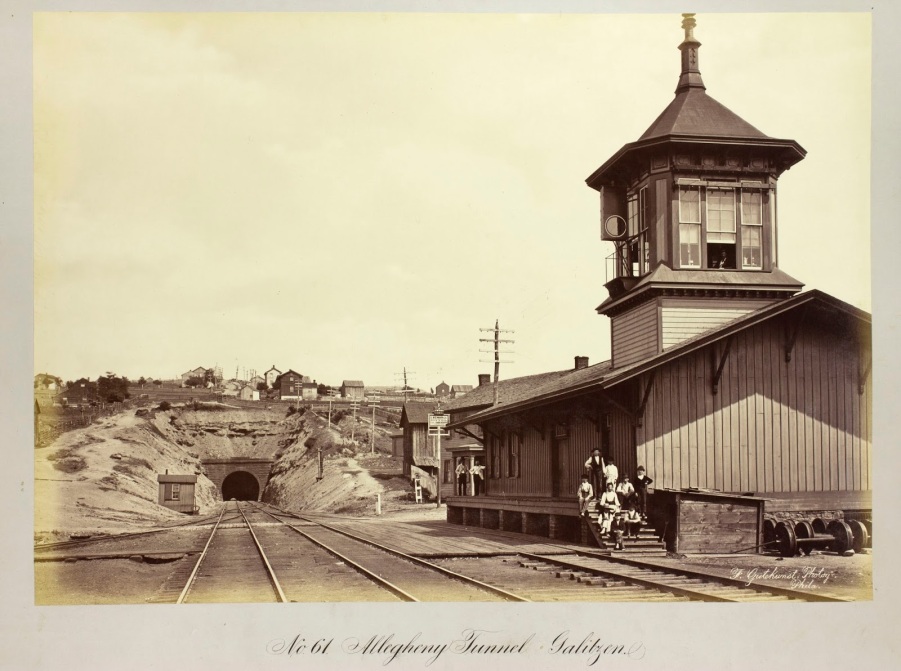 Plate 61, Allegheny Tunnel, Galitzen, Pennsylvania. One of 91 beautiful images from the Album of Frederick Gutekunst’s photographs recently donated to the Library Company of Philadelphia by the Greer family. Image collection of Library Company of Philadelphia
Plate 61, Allegheny Tunnel, Galitzen, Pennsylvania. One of 91 beautiful images from the Album of Frederick Gutekunst’s photographs recently donated to the Library Company of Philadelphia by the Greer family. Image collection of Library Company of Philadelphia
The portfolio, dating from ca. 1875, titled simple “Scenery of the Pennsylvania Railroad” represents one in a series of campaigns the PRR embarked on to celebrate the railroad as a destination, touting the freshly manicured railroad dissecting the wilds of Pennsylvania, following serpentine rivers, paralleling the canals the road made obsolete; a symbol of modern engineering and progress in America. Fittingly the railroad chose photography over traditional illustrations and paintings, providing a tangible image which potential travelers could connect to, a portal into the world of the PRR and the landscape it traveled. Like his contemporary William H. Rau, Gutekunst utilized the large plate view camera to portray the growing railroad as the country recovered from the American Civil War. This remarkable portfolio illustrates the Pennsylvania Railroad before the grand system improvements started under Chief Engineer William H. Brown and his successors, which would last from the late 1870’s well into the first decade of the 20th Century.
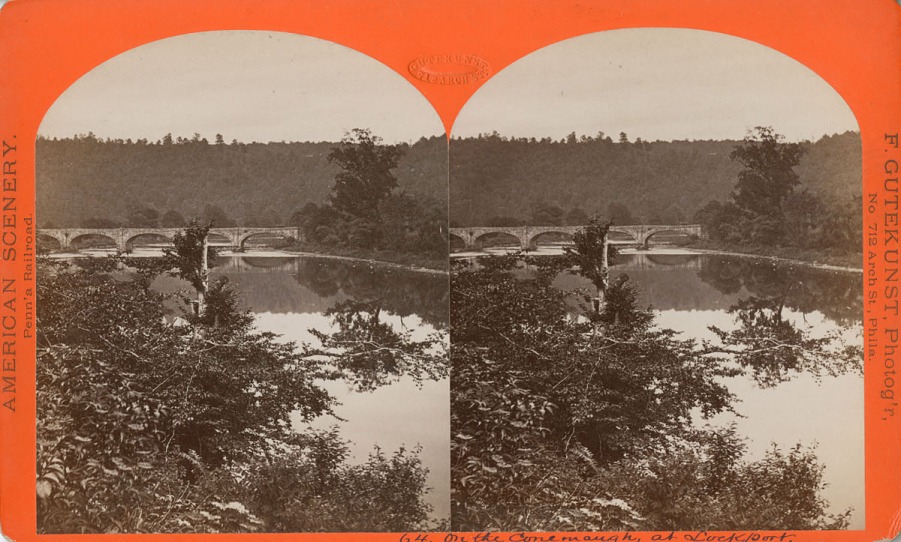 On the Conemaugh at Lockport, Pennsylvania, by Frederick Gutekunst. Up until the PRR portfolio surfaced, much of Gutekunst’s work for the PRR was only known to exist in stereo views like this. Image collection of Library Company of Philadelphia.
On the Conemaugh at Lockport, Pennsylvania, by Frederick Gutekunst. Up until the PRR portfolio surfaced, much of Gutekunst’s work for the PRR was only known to exist in stereo views like this. Image collection of Library Company of Philadelphia.
What makes this donation even more special, especially to PRR preservationists is that we owe a great debt of gratitude to a former Pennsylvania Railroad employee for having the foresight and pride in his employer to save the portfolio.
David St. John Greer, was born in Philadelphia in 1914, his father a laborer and his mother a seamstress. Settling in New Jersey, David completed high school in Pemberton, NJ and enrolled in a 4-year business administration program at Drexel University. Graduating from Drexel in 1937, Greer would begin a 32-year career with the Pennsylvania Railroad. Though the details of his early years with the company are limited, in 1943 despite being exempt as a railroad employee to serve during WWII, he felt compelled to serve his country and enlisted in the Navy. Greer was never deployed in active war but was appointed as the Assistant Supervisor of Exports for the PRR Port of Philadelphia and later served as the District Property Transportation Officer in the Port of Philadelphia Customs House while also acting on the Ports Conditions Committee. Greer was released from active duty in January of 1946 as a Lieutenant returning to his civilian job with the PRR. Over the next 11 years Greer worked all over the system as a Supervising Agent for important terminals like Williamsport, Harrisburg, the company piers of New York, and Philadelphia. In 1953 he was promoted to Superintendent of Stations in the Pittsburgh Region and later the Chicago area from 1955-57. By the end of 1957 Greer was promoted to Manager / Director of Freight Stations and Motor Service on the entire system, responsible for all stations and trucking companies owned by the PRR. In 1968, the fateful year long time rivals PRR and NYC merged Greer was appointed Director of Stations system wide where he served just one short year, deciding that he could no longer work for the merged railroads.
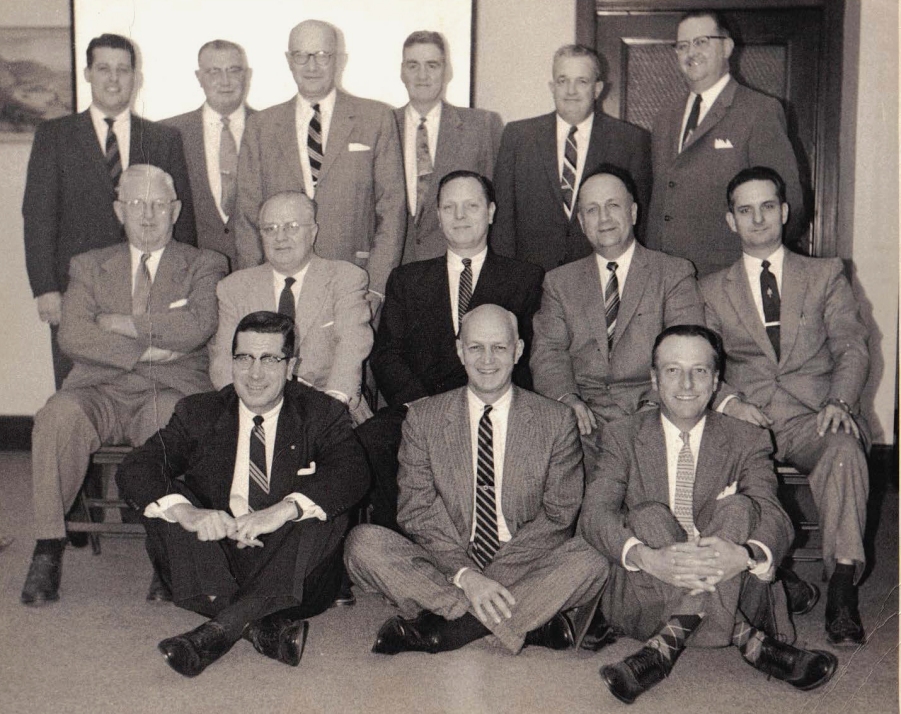 David St. John Greer, pictured here in the center of the middle row (dark suit) was a devoted Pennsylvania Railroad employee who purchased the Gutekunst album after the ill fated merger of the PRR and rival New York Central in 1968. After being in their possession for over 45 years the Greer family decided to donate the album to the Library Company of Philadelphia where it will join a sizable collection of Gutekunst’s work along side the William H. Rau commissions for the PRR. Image courtesy of the Greer Family.
David St. John Greer, pictured here in the center of the middle row (dark suit) was a devoted Pennsylvania Railroad employee who purchased the Gutekunst album after the ill fated merger of the PRR and rival New York Central in 1968. After being in their possession for over 45 years the Greer family decided to donate the album to the Library Company of Philadelphia where it will join a sizable collection of Gutekunst’s work along side the William H. Rau commissions for the PRR. Image courtesy of the Greer Family.
During that last year, the PC worked to wipe the slate of documents and ephemera from the PRR archives offering items for sale to employees and later holding public auctions. It was here that Greer purchased the Gutekunst Album along with a number of other pieces of PRR memorabilia. Greer’s son, David, recalls, “My father loved the PRR and hated the merger. He particularly loved freight operations. He worked in places that included many of the locations in Pennsylvania pictured in the [Gutekunst] photographs and felt a close kinship to the railroad and the state of Pennsylvania. He took good care of the album but would occasionally sit and look at the photos much as I have done for the past twenty years.” David’s father gifted many of the other items he purchased at auction after his retirement, but held on to the album of photographs. “I think it is telling he kept the photographs, clearly the most valuable piece of railroad memorabilia he had. He also kept things that I think reminded him of the good times on the railroad. As an example he kept and displayed the menu from his dinner on the last run of the all Pullman Broadway Limited. The train crew signed the menu and he kept it along with some of the serving pieces that were used for this dinner. I think he felt that the end of the Broadway Limited was the end of an era. He flew to Chicago on business so that he could ride home on the Limited’s last eastbound trip as an all Pullman train, disembarking at Paoli near his home.”
Survived by his daughter Ann Hiros and son David Greer, David St. John Greer passed in December of 1993, leaving the album among other items with the family. In late 2013 I had heard about the album surfacing through PRRT&HS archivist Charlie Horan and in March of 2014 had the pleasure of meeting David on a train trip to Pittsburgh riding the Juniata Terminal Company PRR 120 and the Warrior Ridge (A Ride on the Pennsylvania). Dave expressed his interest in donating the album to a place that not only could care for it properly but also make it accessible to the public. Given my experience with the Rau collection housed at the Library Company of Philadelphia I suggested that David consider the institution, not only because of Gutkunst’s Philadelphia connection but also because of the existing collection of his work already at the LCP. It would also bring together two very important collections of photography that focused on the Pennsylvania Railroad from the 19th Century. At the close of 2014 the Greer family ultimately decided the album belonged in LCP’s permanent collection, adding to an incredible archive of 19th Century prints and photographs. We are lucky to have this resource preserved where it will ultimately be digitized for many future generations to enjoy in the honor of David St John Greer and photographer Frederick Gutekunst.
Watershed Project – Upcoming Exhibition
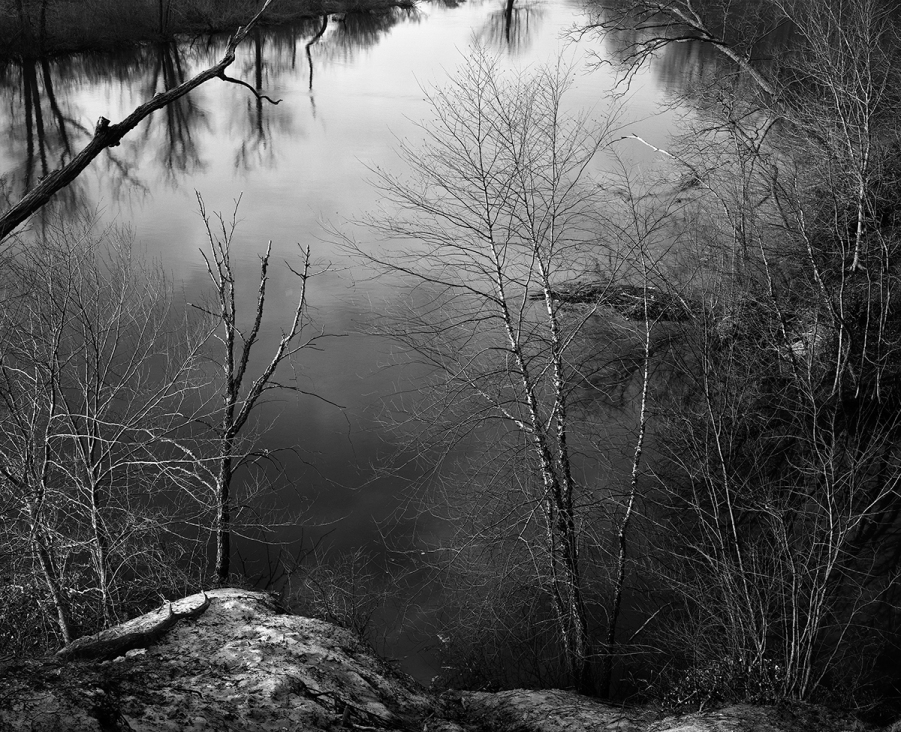 Bluffs on Crosswicks Creek, near Bordentown, New Jersey. This is one of 14 images from the Watershed series that will be part of an exhibition at the Perkins Center for Arts – Collingswood. The show opens Saturday, March 14th with a reception from 6-9pm.
Bluffs on Crosswicks Creek, near Bordentown, New Jersey. This is one of 14 images from the Watershed series that will be part of an exhibition at the Perkins Center for Arts – Collingswood. The show opens Saturday, March 14th with a reception from 6-9pm.
Watershed: The southern half of the Delaware River Basin is steeped in history, once the backbone of shipping and manufacturing and home to countless communities along its banks. The Delaware itself and the many unremarked tributaries that feed into it play host to a diverse Eco system that thrives along side industrial sites, refineries and countless miles of swamp and unremarked landscapes covered in bay grass, scrub pines and oaks. There is a feeling of emptiness in these landscapes, an absence of human life. Scars left behind from dredging dumps and brownfield sites only highlight nature’s resilience to recover these swaths, its ability to thrive even under the duress of neighboring highway noise, pollution and encroaching housing developments. The Watershed Project is about the beauty of the benign and unremarked place challenging our perception of the natural landscape while celebrating an important resource of the greater Delaware Valley.
I am excited to announce that I will be included in a three person exhibition that will open next Saturday, March 14th at the Perkins Center for the Arts in their Collingswood location. Along with artists Keith Yahrling and Amy Becker I will be showing work from the Watershed Project. The exhibition runs from March 14 – May 2, 2015 with an opening reception on Saturday, March 14 from 6-9 pm. The Perkins Collingswood facility is located at 30 Irvin Ave., Collingswood, NJ 08108. Normal exhibition hours are Tuesdays & Thursdays 10 am – 2 pm, Saturday 10am – 2 pm. The exhibition and opening is free and open to the public. Collingswood offers some terrific options for dining so its a perfect opportunity to get out for a night of art and entertainment. Hope to see you there!
Lecture Next Week | Harrisburg Chapter NRHS
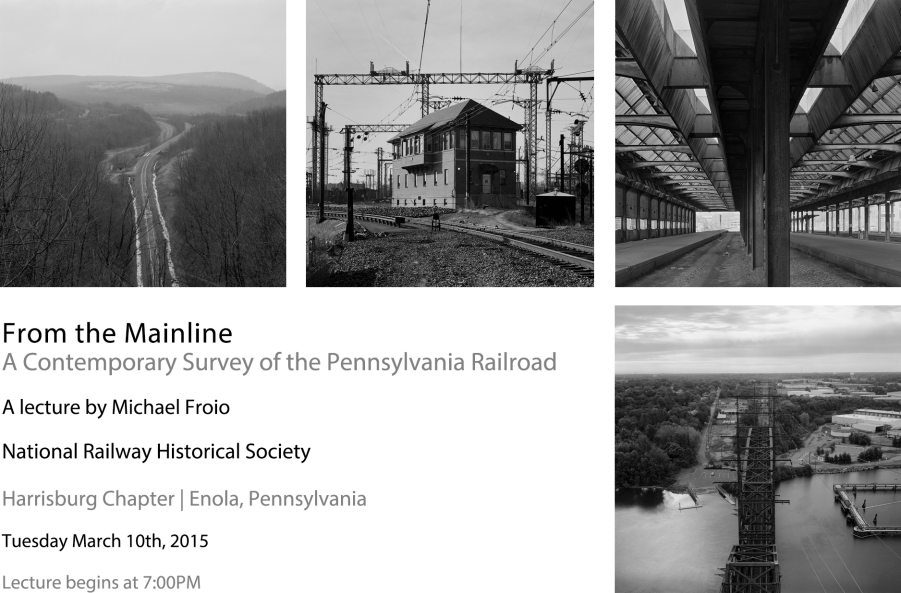
I am happy to announce that I’ll be presenting a slide show and discussion on my ongoing photographic project, From the Mainline: A Contemporary Survey of the Pennsylvania Railroad for the Harrisburg Chapter of the National Railway Historical Society. Inspired by the work of photographer William H. Rau, who was commissioned in the 1890’s to document the PRR and its destinations, the project explores the transitioning landscape along the former PRR mainline from New York to Pittsburgh, highlighting the unique vernacular of facilities and infrastructure built by the PRR. Using large format film based images this project combines historical research and imagery to present a creative documentation of one of the most celebrated railroads in American history for both exhibition and web format. Attendees will also be treated to some of the recent commission work I have been doing for Conrail Shared Assets and some behind the scenes insight on the production of a long term video and time lapse documentation project.
The NRHS was founded in 1935 by a group of rail historians. It has since grown from 40 founding members to include over 13,000 men and women of all ages and professions in every state and many foreign countries, making it the nation’s largest rail preservation and historical society. The Harrisburg Chapter is one of roughly 160 around the country, and widely recognized for its remarkable and innovative preservation efforts including the restoration of Harris Tower and the creation of a interactive installation combining the old interlocking machine with 21st Century technology to recreate the working environment of one of the PRR’s busiest towers. For more information about the Harrisburg Chapter of the NRHS, their activities or to plan a trip to the Harris Tower museum visit their website.
The lecture, on March 10th, 2015, is part of the Harrisburg Chapter’s meeting is free and open to the public and will begin at 7PM at the Hoss’s Steak and Seahouse, 743 Wertzville Road, Enola, Pennsylvania
For more information please contact me directly at michael@michaelfroio.com
Delair Project: Highlight Video Is Live!
Click to view the highlight video release of Delair Project!
The Delair project highlights are live! This documentation included fourteen months of work, at times utilizing up to three photographers, working a total of over 800 man-hours to capture 10 terabytes of imagery through bitter cold, snow, rain and miserable heat, day and night. I would like to thank the people at Conrail and all the contractors and consultants for their assistance and patience, without them this project would not have been possible. I would also like to acknowledge the assistance of Samuel Markey who was an integral part of the entire production and Michael Legrand who’s aerial footage added another dynamic to this already massive undertaking. Please click the image above to check out the highlights of the Delair Improvements Project and as always feedback is much appreciated!
Thank you for your time and support!
Michael Froio
Michael Froio Photography, LLC
Delair Bridge Project: Upcoming Release
In the spirit of anticipation I am excited to announce the release of four trailer videos this week for the upcoming public debut of work from the 14 month project documenting the rebuilding of Conrail Shared Assets Delair Bridge. The Delair Bridge, completed in 1896 and heavily modified in the late 1950’s is a vital link between Conrail’s South Jersey operations and parent companies CSX and Norfolk Southern’s transportation networks. With this upgrade Conrail can now handle heavier loads and larger trains fostering economic growth in Southern New Jersey. This project is part of an $18.5 million Transportation Investment Generating Economic Recovery (TIGER) grant awarded to the South Jersey Ports by the US Department of Transportation.
I was initially asked to provide a basic documentation for the project which grew into a major production conducted over 6 – three day/ 72 hour scheduled outages where up to 13 bridge spans were replaced and track renewed. As you can imagine a project of this scope cannot be done by one person; I was fortunate enough to work with two other very talented Drexel Photography graduates; Samuel Markey (Class of 2011) who contributed his extensive knowledge of time lapse production, shooting and editing and Michael Legrand (Class of 2000) who provided aerial footage which added an amazing element to the documentation. At times we utilized up to six cameras to capture the various crafts working together to meet the tight deadlines the railroad required in order to minimize service disruptions. Several contractors including Cornell Steel, Thackray Crane and Railworks were managed by Jacobs Engineering to complete scheduled work within the allotted 72 hour slot through snow, rain, extreme temperatures and physical conditions. Next week you can expect more trailer releases and the finished highlight reel which is slated to go live late in the week. I hope you enjoy the work! As always please feel free to comment and share!
Last week for Monmouth Museum Exhibition!
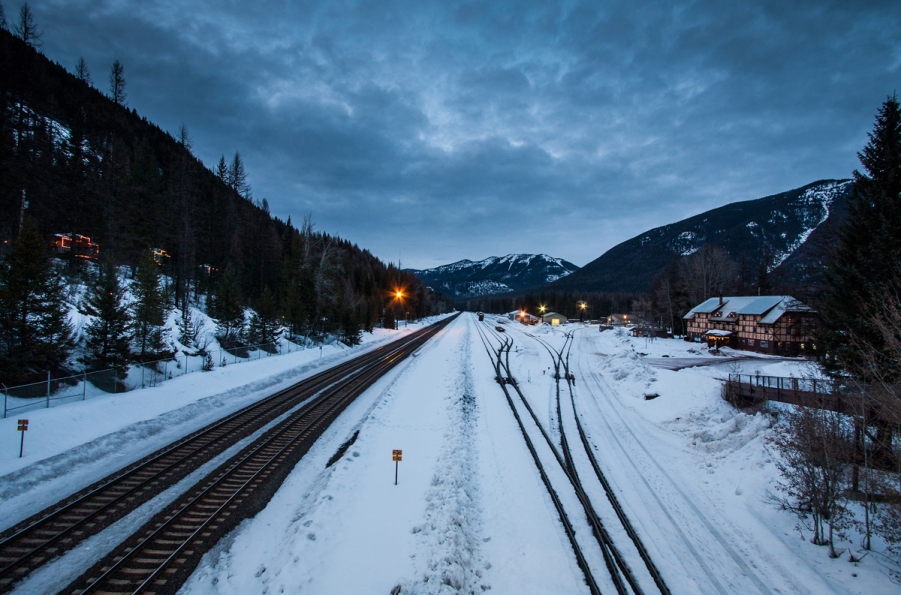 The Izaak Walton Inn was constructed by the Great Northern Railway in 1939 just outside of Glacier National Park near Essex, Montana. This image is one of several by contemporary photographer Travis Dewitz included in the exhibition “All Aboard! Railroads and the Historic Landscapes They Travel” at the Monmouth Museum in Lincroft, NJ. Image courtesy of Travis Dewitz.
The Izaak Walton Inn was constructed by the Great Northern Railway in 1939 just outside of Glacier National Park near Essex, Montana. This image is one of several by contemporary photographer Travis Dewitz included in the exhibition “All Aboard! Railroads and the Historic Landscapes They Travel” at the Monmouth Museum in Lincroft, NJ. Image courtesy of Travis Dewitz.
If you have not had a chance please take the time to visit the Monmouth Museum to view the exhibition “All Aboard! Railroads and the Historic Landscapes They Travel”. This visually stunning and informative exhibition will be on view for another week, closing January 4th, 2015. For hours and additional information, please call the Museum at 732-747-2266, or visit the website at: www.monmouthmuseum.org. Museum admission is $7 per person
The Monmouth Museum, a private, non-profit organization, is located at 765 Newman Springs Road, in Lincroft, NJ.
Merry Christmas from the Mainline !
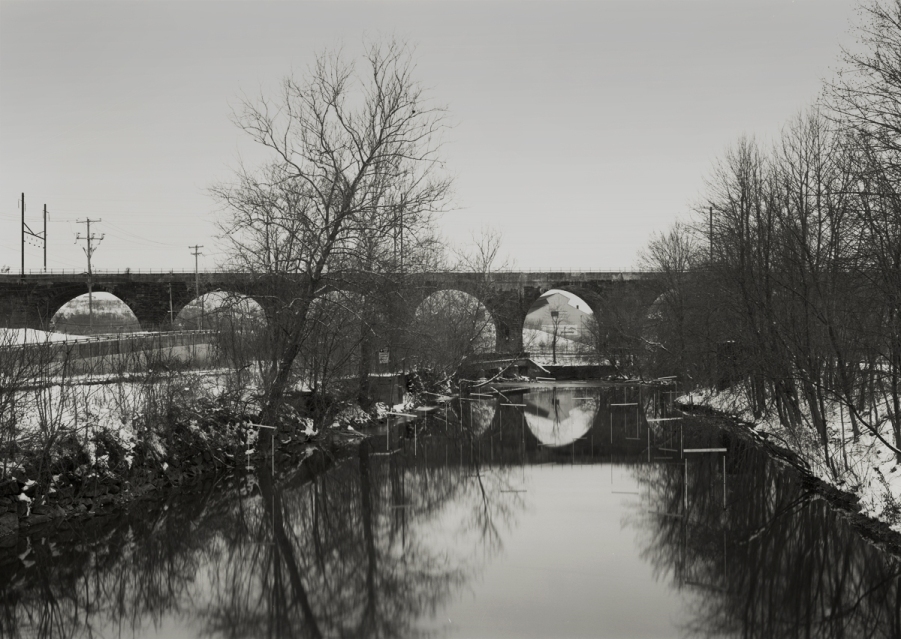 The railroad never stops, nor does the industry it serves. In the shadow of the Coatesville bridge spanning the west branch of the Brandywine River the former Lukens steel mill hums with activity around the clock providing jobs for people in the surrounding communities. As we enjoy the company of family during the holidays, men and women leave home to work in the plant day and night, producing specialized steel to build America’s bridges, buildings and infrastructure. For some, working through the holidays seems unthinkable, to the folks in the steel or transportation industry its business as usual. Whether you are home with loved ones or on the job, I would like to wish you all a Merry Christmas !
The railroad never stops, nor does the industry it serves. In the shadow of the Coatesville bridge spanning the west branch of the Brandywine River the former Lukens steel mill hums with activity around the clock providing jobs for people in the surrounding communities. As we enjoy the company of family during the holidays, men and women leave home to work in the plant day and night, producing specialized steel to build America’s bridges, buildings and infrastructure. For some, working through the holidays seems unthinkable, to the folks in the steel or transportation industry its business as usual. Whether you are home with loved ones or on the job, I would like to wish you all a Merry Christmas !
Happy Holidays from Michael Froio Photography
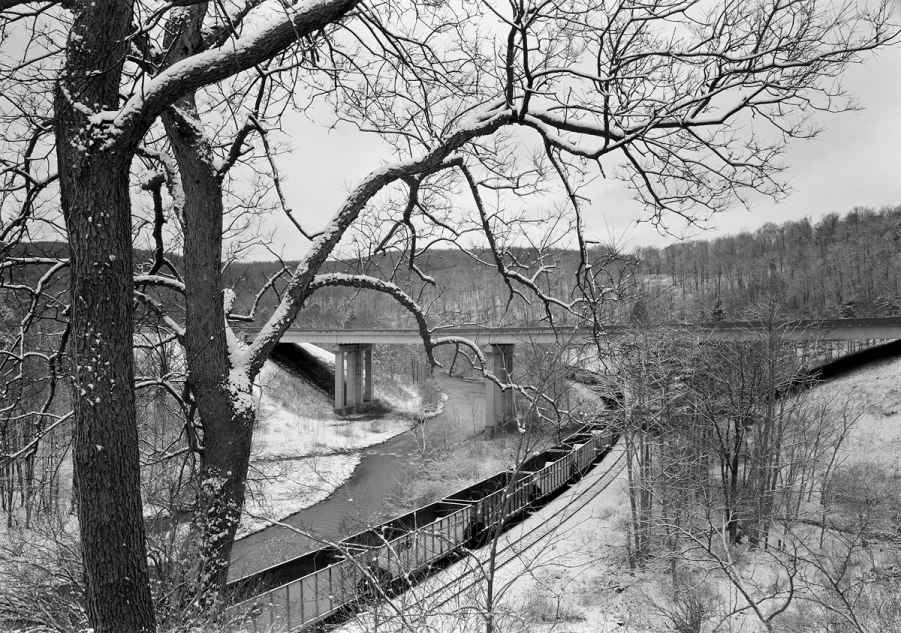
Friends, As 2014 winds down and we are amidst the holiday season I’d like to take a moment to thank everyone for all the wonderful words and support. Between formally becoming a small business owner, commercial commissions, lectures, curating an exhibition, writing, research and making photographs for the Mainline Project it has been a truly amazing year. I look forward to taking the final days of 2014 to reflect on the year and spend some much-needed time with the family. Looking forward to 2015 there is a number of events on the horizon,more information will follow after the start of the New Year. I have taken a moment to assemble here some of my favorite holiday posts from years past, enjoy and happy holidays from my family to yours!
Sincerely,
Michael Froio
Holiday Traditions: Story of the Night before Christmas Paintings by PRR employee William W. Seigford Jr.
This time of year, family and friends come together to celebrate the holidays with traditions developed over generations. As a part of our family tradition I have the pleasure to read to my children on Christmas Eve as my father did before, the fabled poem, The Night Before Christmas by Clement Clark Moore. First published anonymously in December of 1823, it is now the tradition in many American families to read the poem on Christmas Eve.
The story and illustrations presented here were made in 1953 by Pennsylvania Railroad employee, William W. Seigford Jr. who maintained an office at the Harrisburg Passenger Station. They were displayed in the station during the Christmas season alternating with other decorations for several years until Seigford was transferred to Cincinnati in 1956. The paintings were never displayed in Cincinnati but remained in Seigford’s possession until he retired from Penn Central as General Foreman of Passenger Locomotives and Cars in July of 1974. After retirement he returned to the Lancaster area and subsequently donated the paintings to Amtrak’s Lancaster Passenger Station for display during the Christmas season. Surviving the Pennsylvania Railroad and Penn Central, all 12 original paintings hang proudly in the beautiful 1929 waiting room under the watchful eye of Amtrak employees Richard Peiffer and Donna Whitney, who facilitated the making of these reproductions for future preservation.
I would like to acknowledge Mr. William (Bill) L. Seigford for his help on this post as well as his continued support on the Mainline Project, his knowledge and generosity have been a invaluable resource.
The Lionel Corporation: Model Railroad Icon of the Holiday Season
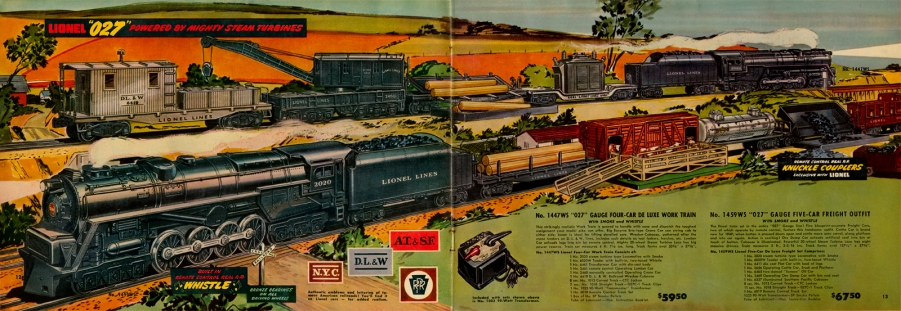 Page 12-13 of Lionel’s 1947 product catalog illustrating the deluxe train sets # 1447WS and 1459WS featuring accessories including the log dump car and working cattle pen. Note the locomotive which is modeled after the PRR’s failed S2 steam turbine locomotive, which ironically Lionel produced more of than the Juniata Shops! Original 1947 catalog collection of the author.
Page 12-13 of Lionel’s 1947 product catalog illustrating the deluxe train sets # 1447WS and 1459WS featuring accessories including the log dump car and working cattle pen. Note the locomotive which is modeled after the PRR’s failed S2 steam turbine locomotive, which ironically Lionel produced more of than the Juniata Shops! Original 1947 catalog collection of the author.
With modest beginnings Joshua Lionel Cowen and Harry C. Grant founded the Lionel Corporation in 1900, building model trains for retail window displays to help draw consumers to their stores. In 1906 the company responded to the increasing demand for the electric trains in the consumer market and developed its trademark three-rail “standard gage” track to simplify wiring and use of accessories. By 1915 Lionel would supplement the large standard gage with the budget minded O scale which would later become the standard size of their product lines. Lionel’s use of sharp advertising was ultimately responsible for tying model trains to Christmas, making them popular presents during the holidays, establishing traditions that survive today. By WWI Lionel was one of three major US manufactures of toy trains, surpassing competitor Ives as the market leader by the 1920’s. Lionel’s growth and aggressive ad campaigns further led to Ives’ bankruptcy in 1928.
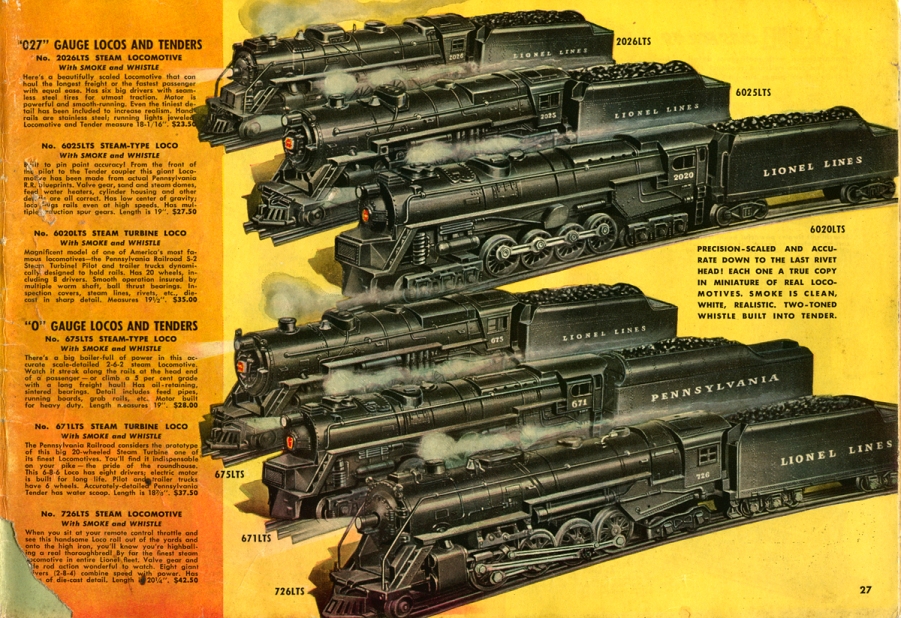 Lionel 027 gage locomotives and tenders! No Lionel layout was complete with extra motive power, this includes many Pennsy inspired locomotives lettered in both the classic Lionel Lines and PRR. Original 1947 catalog collection of the author.
Lionel 027 gage locomotives and tenders! No Lionel layout was complete with extra motive power, this includes many Pennsy inspired locomotives lettered in both the classic Lionel Lines and PRR. Original 1947 catalog collection of the author.
Like many other companies, the Great Depression would be a severe detriment to Lionel’s business, as a result their 1927 operating profit of over $500,000 plummeted to $82,000 in 1930, and ultimately a loss in 1931 of over $200,000 putting Lionel into receivership by May of 1934. A product credited with saving Lionel during the Depression era was a wind up hand car featuring Mickey and Minnie Mouse which Lionel sold well over 250,00 units providing the cash flow to keep the company from closing.
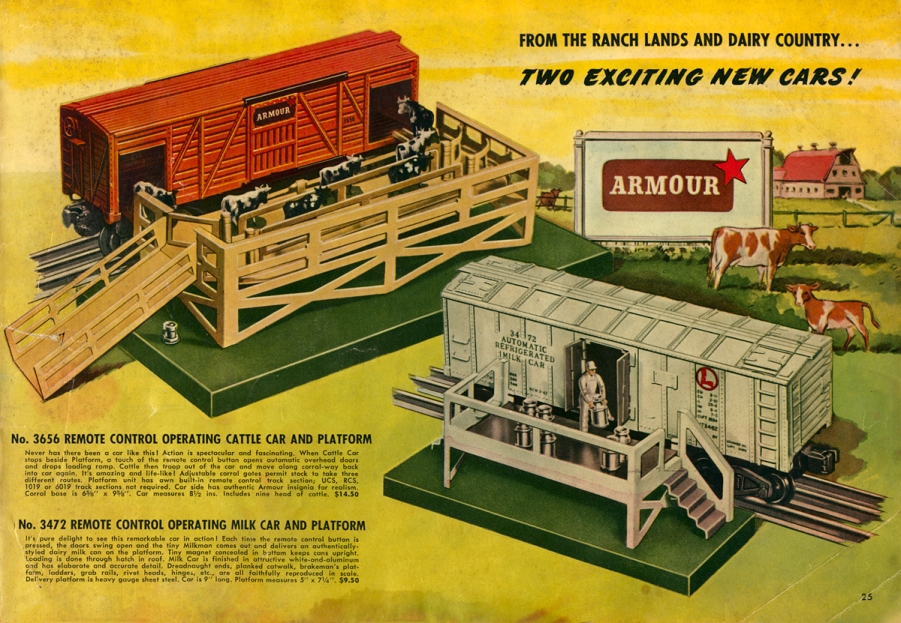 “From the Ranch Lands and Dairy Country!” Lionel was well known for there operating accessories including the Cattle Car and Milk cars both which were accompanied by track side platforms for loading and unloading. Original 1947 catalog collection of the author.
“From the Ranch Lands and Dairy Country!” Lionel was well known for there operating accessories including the Cattle Car and Milk cars both which were accompanied by track side platforms for loading and unloading. Original 1947 catalog collection of the author.
In 1942 Lionel ceased toy production to produce items for the United States Navy during World War II. Regardless of the lack of toy train production, the advertising department pushed heavily to urge American teenagers to start planning their post-war layouts. By late 1945 Lionel resumed production, replacing their original product lines with more realistic trains and accessories exclusively in O Scale. Considered by many aficionados as the golden years, 1946-1956 saw sales soaring with new items including the famous Santa Fe Warbonnet EMD F3 locomotives as well as the Pennsylvania Railroad GGI and experimental S2 steam turbine locomotive. During the 1950s Lionel would tout its short-lived title of largest toy manufacturer, out selling American Flyer almost 2:1. After 1955 sales declined steadily with the rising popularity of the smaller but more realistic HO Scale and to many the end of the true “Lionel era” was in 1959. Over the years Lionel was diversified unsuccessfully and the name survived in different ways including retail toy outlet Lionel Kiddy City. Today the Lionel name remains the most famous name in model trains, though not associated with the original corporation, Lionel LLC owns most of the product rights and trademarks continuing the legacy started by American businessmen Joshua Lionel and Harry Grant well over 100 years ago.
Holiday Travel: A vintage add from the Pennsylvania Railroad
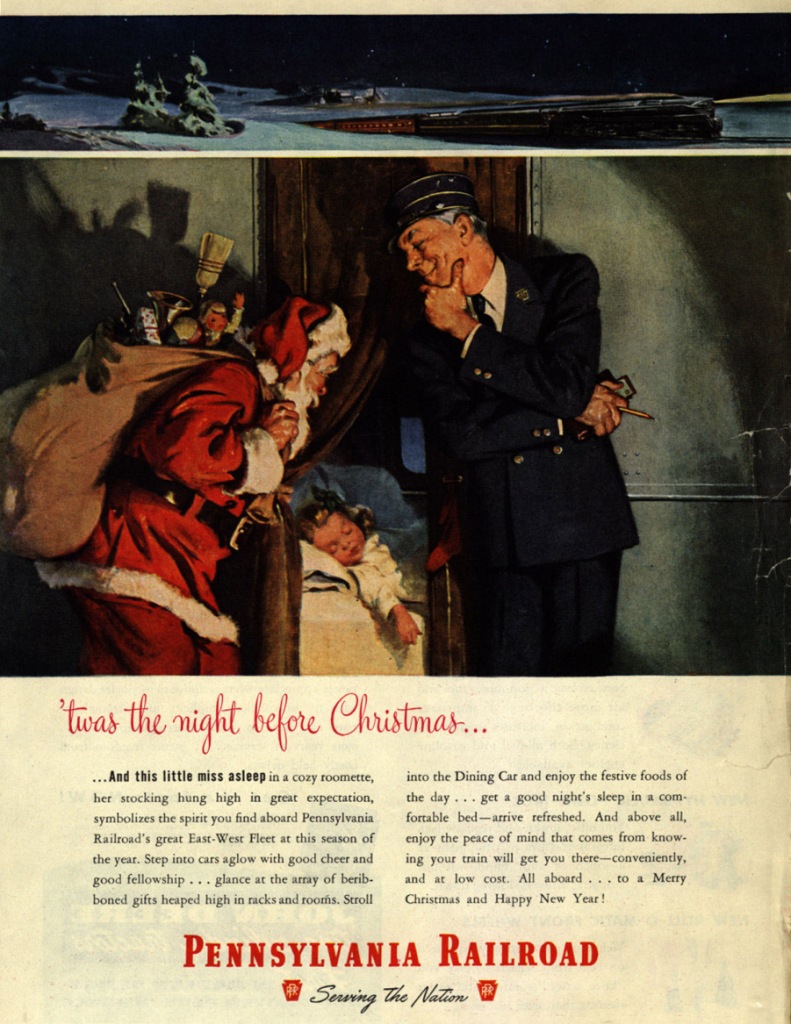
William H Brown: The Tale of Two Bridges
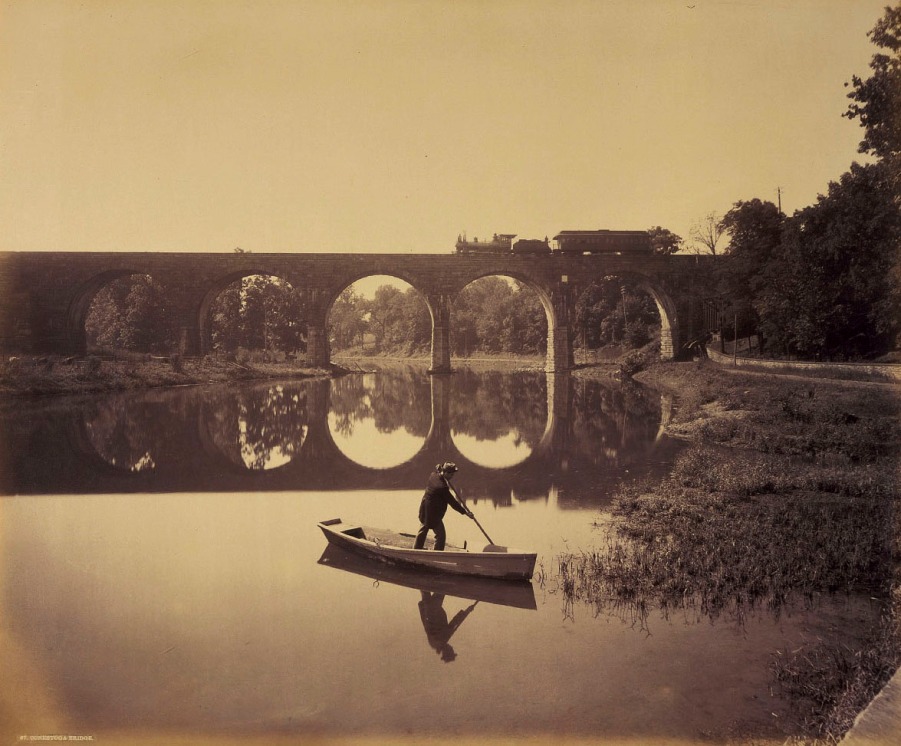 In a beautiful image by William H. Rau we see the Conestoga River bridge, one of Brown’s first stone bridges. Utilizing the figure and boat as a device for scale in the foreground Rau is looking south, as noted by the finished facade of the bridge. To the left out of view is the Lancaster Water Works which still survives today. Photograph collection American Premier Underwriters, Inc.
In a beautiful image by William H. Rau we see the Conestoga River bridge, one of Brown’s first stone bridges. Utilizing the figure and boat as a device for scale in the foreground Rau is looking south, as noted by the finished facade of the bridge. To the left out of view is the Lancaster Water Works which still survives today. Photograph collection American Premier Underwriters, Inc.
In 1881 a rising figure in the Pennsylvania Railroad by the name of William H. Brown was promoted to chief engineer. At 45 years old the Lancaster County native had 31 years under his belt working his way from a rod man on a survey crew in 1850 to the top of one of the most ambitious engineering departments in the railroad world. Brown had a reputation for knowing every grade, curve and crossing on the PRR. As chief engineer his tenure was likely one of the most notable in the transformation of the Pennsylvania Railroad’s physical plant during the 19th and early 20th centuries, implementing various programs of improvements up until his retirement in 1906. According to his obituary in the New York Times he, “made 133 changes and revisions to the mainline, built fourteen elevated railways through cities, forty-one tunnels, and 163 stone bridges, including [the world’s largest] Rockville stone bridge.” The last point was perhaps one his more notable achievements and certainly one of the most recognizable today; the stone masonry arch bridge.
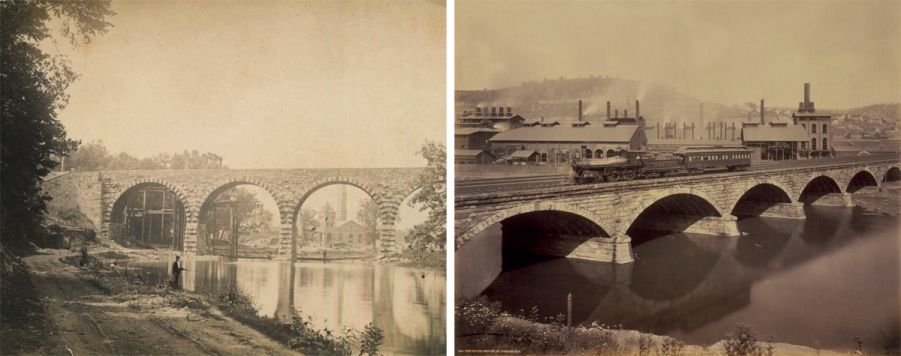 The connection between Brown’s first two stone bridges are linked to various correspondence in the planning stages for both locations. Born from the endorsement of stone bridges during the four track expansion, they diverged at the time of design. The Conestoga is two tracks with provisions for expansion (note protruding stone work along the arches) the Conemaugh bridge designed and built with four tracks. Both survive today and remain in active service on Amtrak’s Keystone corridor and Norfolk Southern’s Pittsburgh line respectively. Left detail; Photographer unknown, image courtesy of LancasterHistory.org, Lancaster, Pennsylvania. Right detail William H. Rau, collection of American Premier Underwriters, Inc.
The connection between Brown’s first two stone bridges are linked to various correspondence in the planning stages for both locations. Born from the endorsement of stone bridges during the four track expansion, they diverged at the time of design. The Conestoga is two tracks with provisions for expansion (note protruding stone work along the arches) the Conemaugh bridge designed and built with four tracks. Both survive today and remain in active service on Amtrak’s Keystone corridor and Norfolk Southern’s Pittsburgh line respectively. Left detail; Photographer unknown, image courtesy of LancasterHistory.org, Lancaster, Pennsylvania. Right detail William H. Rau, collection of American Premier Underwriters, Inc.
Two of the earliest spans Brown designed for the mainline were the crossing of the Conemaugh River in Johnstown and the Conestoga in Lancaster. Though bid separately both were originally to be constructed utilizing iron truss spans until Pittsburgh Division superintendent Robert Pitcairn endorsed the use of stone to Brown instead. Touting stone’s strength, durability and its abundant supply on the PRR, the stone bridge would be a long term solution, able to support the growing traffic and heavier trains the PRR was becoming accustomed to. It was there that the course divided for the two bridges. The Conemaugh bridge was built as planned with four tracks and the first to prove Pitcairn’s endorsement true surviving the wrath of the great flood of 1889 just a year after its completion.
With bridge renewals a major part of the program to expand the PRR’s trademark four track mainline across the state of Pennsylvania, the Brandywine Creek bridge in Coatesville and the Conestoga bridge in Lancaster were the last remaining two track spans west from Philadelphia. As discussed previously, the Lancaster terminal was also a choke point in the movement of traffic necessitating the construction of the Lancaster Cut-Off. Just to the east of the junction of this new route with the old main was the Conestoga River, a 61-mile tributary of the Susquehanna. The crossing of the Conestoga saw several successive bridges built for the railroad; the first a 1400’ long series of wood lattice truss spans dating from the P&C which was consumed by fire and later replaced with a fill and a shortened series of iron Whipple trusses around the Civil War. Though Brown had considered another iron design for Conestoga in 1887 its design ultimately followed the fate of the Conemaugh bridge, choosing to use stone instead. Though initial correspondence suggests the Conestoga bridge was to be a four-track span, costs and traffic levels dictated a compromise in design, building a two-track span with provisions in place for expansion. As a result the five arch, 329’ long stone masonry bridge was constructed with foundations to support a four track span. In addition, contractors left stones protruding from the southern side of the bridge, which would allow for any expansion to tie into the existing structure when demand necessitated. Completed in 1888 traffic grew through the next decade but plans were on the horizon that would direct freight off the mainline to a new dedicated low-grade from Atglen to Columbia, by-passing Lancaster all together. Though the span in Coatesville was replaced in 1906 to support the combined traffic demands east of Atglen the Conestoga bridge was never expanded, nor was the mainline between Lancaster and Royalton since the PRR now had three two-track routes for both freight and passenger moves via the mainline, Atglen & Susquehanna low grade and the Columbia branch.
Today many of Brown’s bridges are still in service without remark; the only exception of course is Shock’s Mills, which partially failed during Hurricane Agnes in 1972. Building like the Romans for an empire in the transportation world, Mr. Brown and other people like him on competing railroads represented the pinnacle of engineering, design and forethought that built the United States and are largely responsible for the rail networks we have today.
